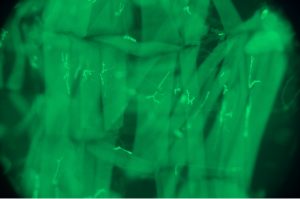Over a year ago, I was met with the news that BSURF would be canceled because of the pandemic. While many things have changed between then and now, I am grateful to have still been able to be a summer research fellow. In these past eight weeks, things have continued to change for me; I’ve grown, not only in my knowledge and research skills, but in my confidence, communication, and passion for science.
I remember my first day in Dr. Sherwood’s lab like it was yesterday: looking at flies under the microscope, learning about our project for the first time, and cringing every time I had to handle a fly vial. My first larval dissection took me about twenty minutes and looked horrendous. Now, I can do some in under five minutes and make them look better than my first. I also get embarrassingly excited when one of our crosses finally starts producing larvae, or when it’s finally time to look at my dissections under the microscope. Simply put, I have fully embraced the experience of being a fruit fly biologist. My time in the lab also came with the development of my personal skills – no longer being afraid to ask “dumb” questions, owning up to my mistakes without shame, and effectively communicating my science.
Despite not being able to get to every aspect of our project in these eight short weeks, my enthusiasm for our project is unchanging. I am beyond excited for what the future will hold for our lab, especially considering our results that remain to be analyzed. While research tends to be more failures than successes, the breadth of information I learned, and the valuable mentorship I received from Dr. Sherwood, are more than enough to compensate for the drawbacks of our research. I can’t wait to get back to BioSci in the fall and keep up the wonderful work we do!


